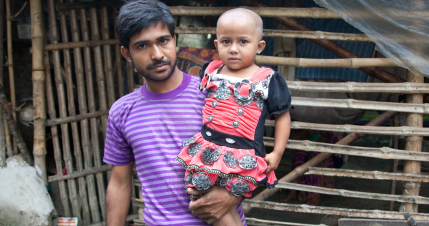- Passing on the Polio legacy- Social Mobilization Network Deployment to new locations
- Guidelines for the use of the Communication kit for the tOPV to bOPV SWITCH
- tOPV to bOPV SWITCH FAQs for Cold Chain Handlers and ANMs-English
- tOPV to bOPV FAQs for Cold Chain Handlers and ANMs-Hindi
- tOPV to bOPV SWITCH Fact Sheet-English
- tOPV to bOPV SWITCH Fact Sheet-Hindi
- tOPV to bOPV SWITCH Segregation Tape-Bilingual
- tOPV to bOPV SWITCH job aid for Cold Chain Points-English
- tOPV to bOPV SWITCH job aid for Cold Chain Points-Hindi
- tOPV to bOPV Poster for Cold Chain Points-English
- tOPV to bOPV Poster for Cold Chain Points-Hindi
- E-Brochure: Before the tOPV to bOPV SWITCH
- E-Brochure: After the tOPV to bOPV SWITCH
- SMSes for tOPV to bOPV SWITCH
West Bengal
India’s last case of wild poliovirus was recorded in West Bengal on 13 January 2011, when a two-year-old girl from Howrah District, near Kolkata, was infected (see case study above). Subsequent laboratory testing showed that this wild poliovirus was most closely genetically related not to a recent polio outbreak in nearby Murshidabad, but to a sewage sample collected in five months before in north Delhi, more than 1000 kilometres away. This link clearly highlighted both the ability of the wild poliovirus to travel quickly across large distances, and the transient nature of the population in West Bengal. Both these factors underlined the importance of reaching mobile and migrant groups with polio vaccination every time it was offered.
Programme Structure
The polio programme in West Bengal is focused in four highest-risk districts: Howrah, Murshidibad, Kolkata Municipal Corporation and South 24 Parganas. UNICEF has partnered with nine non-government organisations in these districts, with more than 1000 Field Volunteers trained to conduct social mobilization to increase immunization coverage and tackle resistance to the oral polio vaccine. This army of social mobilizers are supervised by four District Extenders, three Training Coordinators and a State Coordinator. Prior to an immunization round the mobilizers are responsible for counselling families to have their children vaccinated, contacting and mapping influencers, contacting mosques to generate announcements advertising the polio campaigns and appeal to the Imams to open the polio booths and assist in tackling resistance, and with accompanying house-to-house vaccination teams.
For more detail on activities in the lead up and during a polio immunization round click here.
In West Bengal, polio immunization rounds are launched on a Sunday Booth Day, where children are invited to attend fixed site booths, followed by four days of house-to-house campaigns, where vaccinators and social mobilizers go door-to-door to every house to immunize all children <5 years of age. In West Bengal, traditional media has been employed to tackle resistance to OPV, with special ‘talking doll’ puppet shows held to raise community awareness, as well as local theatre shows and magic shows. Other social mobilization activities include mothers’ meetings, youth club meetings, visits with religious leaders to generate support among Muslim communities, polio classes in primary schools, school rallies and ‘miking’ autorickshaws.
Challenging Conditions
Many of the conditions that have allowed poliovirus to flourish in Uttar Pradesh and Bihar are prevalent in West Bengal. With a population of 91 million, it’s the fourth most populous state in India. Like elsewhere in India, poor, marginalised Muslim communities have been disproportionately hit by polio; while Muslims make up around a quarter of the state population, all except for one of the 101 polio cases in West Bengal over the last decade have been Muslim children. While Routine immunization rates in West Bengal are comparatively high (with more than 60% of one-year-olds fully immunized), in the highest-risk blocks of the state full RI coverage can be as low as 18%. Open defecation is common. Rural villages are dotted with ‘pukurs’ or traditional water ponds, where communities use the same often putrid water for bathing, cleaning utensils, going to the toilet and washing dirty nappies. West Bengal’s poorest communities are often highly mobile, moving to and from other states like Gujarat, UP, Bihar and Maharashtra looking for manual work such as tailoring or embroidery, agriculture, or working in the brick kiln or construction industry.


